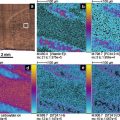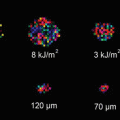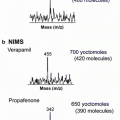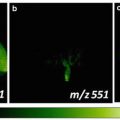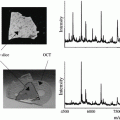© Springer Science+Business Media New York 2015
Lin He (ed.)Mass Spectrometry Imaging of Small MoleculesMethods in Molecular BiologyMethods and Protocols120310.1007/978-1-4939-1357-2_55. MALDI Mass Spectrometry Imaging of Lipids and Primary Metabolites on Rat Brain Sections
(1)
Centre de Recherche de Gif, Institut de Chimie des Substances Naturelles, CNRS, Avenue de la Terrasse, 91198 Gif-sur-Yvette, France
Abstract
Matrix-assisted laser desorption/ionization mass spectrometry imaging (MALDI MSI) enables the localization and the structural identification of a large set of molecules on a surface with 10–20 μm resolution. MALDI is often coupled to time-of-flight (TOF) tandem analyzers which remain a versatile instrument for the detection and the structural analysis of molecular ions. This technique can be used to locate either large biomolecules, such as peptides/proteins, or small endogenous or exogenous ones. Among them, lipids and primary metabolites are of high interest because they can reflect the cell state. This chapter is thus dedicated to the analysis, on rat brain tissue sections, of lipids in positive and negative ion modes, and primary metabolites in the negative ion mode. A particular attention is paid to the structural characterization of lipids using lithium cationization in the positive ion mode.
Key words
Matrix-assisted laser desorption/ionizationTime-of-fightMass spectrometry imagingTandem mass spectrometryLipidPrimary metabolite1 Introduction
Mass spectrometry imaging (MSI) has gained importance since the last 15 years. Matrix-assisted laser desorption/ionization (MALDI) MSI was firstly described in 1994 by Spengler [1] and by the group of Caprioli in 1997 for the localization of peptides and proteins on tissue surface [2, 3]. Since these first demonstrations, the technique was hardly improved in terms of robustness, sensitivity, spatial resolution, and data analysis. Nevertheless, the identification of the peptide/protein peaks in the m/z range between 1,500 and 25,000 remains highly challenging and requires either unsensitive top-down approaches [4] or extraction/digestion/separation steps [5]. In parallel, MALDI MSI was also used for the localization of lipid [6, 7] and primary metabolite [8] ion species in the m/z range between 250 and 1,500. In fact lipids are major constituents of cells and partially reflect the tissue state. Moreover, due to the development of instruments, such as time of flight (TOF) [9] or Orbitrap™ [10], exact mass measurements can be performed directly on tissue sections. MS/MS capabilities of most of the mass spectrometers dedicated to MSI allow the rapid structural identification of the lipid species without requiring extraction or separation.
In this chapter sample preparation for MALDI MSI of lipids [11, 12] and primary metabolites [8] on rat brain sections is described in positive and negative ion modes. In fact rat brain can be considered as a good model sample due to its high availability, its easy sample preparation, and its lipid composition depending on the different anatomical areas. Moreover, lithium cationization of the lipid species leads to better structural characterization in the positive ion mode [13]. For matrix deposition, several automated technologies are commercially available. Most of them are based on the nebulization of the matrix solution on the tissue section using a robot and allow reproducible sample preparation. Because of its ease of use and robustness, the methods presented here were developed using the TM-Sprayer™ from HTX-Imaging.
2 Materials
2.1 Chemicals
1.
α-Cyano-4-hydroxycinnamic acid (CHCA): 10 mg/mL, in acetonitrile/water/trifluoroacetic acid (70/30/0.1, ν/ν/ν).
2.
9-Aminoacridine (9-AA): 10 mg/mL in ethanol/water (70/30, ν/ν).
3.
Lithium trifluoroacetate.
4.
Trifluoroacetic acid.
5.
HPLC-grade water.
6.
Ethanol.
7.
Acetonitrile.
8.
Sodium pentobarbital.
9.
Optimal cutting temperature (OCT) embedding medium.
10.
Dry ice.
2.2 Instruments and Materials
1.
TM-Sprayer™ from HTX-Imaging (Carrboro, NC, USA) or equivalent robot for matrix deposition.
2.
4800 MALDI TOF/TOF mass spectrometer from AB Sciex (Les Ulis, France) equipped with 4000 Series Imaging software (www.maldi-msi.org, M. Stoeckli, Novartis Pharma, Basel, Switzerland) and Tissue View software (AB Sciex, Les Ulis, France) or equivalent.
3.
Cryostat (model CM3050-S; Leica Microsystems SA, Nanterre, France, or equivalent).
4.
Optical microscope (Olympus BX 51 fitted with ×1.25 to ×50 lenses) (Olympus France SAS, Rungis, France) equipped with a Color View I camera, monitored by CellB software (Soft Imaging System GmbH, Münster, Germany) or equivalent.
5.
Desiccator.
6.
Sonicator device.
7.
Vortex mixer.
8.
Sample plate for MALDI instrument (conductive glass slide coated with indium tin oxide or stainless steel plate).
3 Methods
3.1 Tissue Sectioning
All experiments on rat brains were performed in accordance with the protocols approved by the National Commission on animal experimentation and by the recommendations of the European commission DGXI.
1.
Euthanize male Wistar rats of typical 400 g weight by an intraperitoneal injection of sodium pentobarbital (>65 mg/kg).
2.
Freeze the trimmed tissue blocks immediately in dry ice to prevent crack formation during freezing and store at −80 °C prior to MS experiments (see Note 1 ).
3.
Add a few drops of OCT embedding medium and quickly deposit the tissue block over it to fix the frozen tissue block to the cryostat adapter (see Note 2 ).
4.
Cut tissue section of 12 μm thickness using the cryostat at −20 °C.
5.
6.
Store the samples at −80 °C in a box to prevent degradation by ice.
7.




Before MS analysis, warm the sample at room temperature for a few seconds and dry it under vacuum at a pressure of a few hPa for 30 min in a desiccator. Calibrants can be deposited on the tissue section required for the instrumental optimization.
Stay updated, free articles. Join our Telegram channel

Full access? Get Clinical Tree



